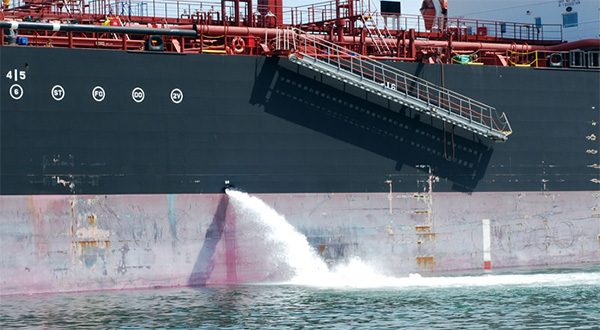As of July 2016, the Coast Guard has determined that 56 foreign administration approved ballast water management systems (BWMS) have met the criteria for acceptance as AMS. To be eligible for use, an AMS must be installed on a vessel prior to the date the vessel is required to comply with the ballast water discharge standard (BWDS).
USCG has issued a bulletin to provide an update on aspects of the Coast Guard’s AMS program and includes guidance to comply with Title 33, Code of Federal Regulations (CFR) Part 151, Subparts C and D. It clarifies CG-OES Policy Letter No. 13-01, Revision 2 by providing details on the 5 year AMS provision allowed under the regulation
To be eligible for use, an AMS must be installed on a vessel prior to the date the vessel is required to comply with the ballast water discharge standard (BWDS). A vessel may continue to manage ballast water with an AMS for up to 5 years after the date it is required to comply with the BWDS implementation schedule in 33 CFR 151.1512(b) or 151.2035(b). Revocation of type approval by the approving authority will result in revocation of an AMS acceptance. (See 33 CFR 151.2026 and CG-OES Policy Letter No. 12-01 for details of the AMS Provision.)
Extension of Compliance Date and AMS Installation
A vessel discharging ballast to waters of the United States after its original compliance date must either ensure the discharged water meets the BWDS, use an AMS (if allowed), or have obtained the water from a U. S. public water supply. However, the master, owner, operator, agent, or person in charge of a vessel may apply to the Coast Guard for an extension to the implementation schedule (compliance date) if they can document that, despite all efforts, the vessel is not able to comply with the ballast water management requirements.
The Coast Guard does not require that an AMS installed on a vessel be used to meet the ballast water management requirements. A vessel with an installed AMS may request an extension and operate under the terms of the extension rather than use the AMS, or it may employ other BWM methods available under the regulation. A vessel operating under an extension to its compliance date may install an AMS and choose not to use it during the period of extension. If a vessel operating under an extension to its compliance date installs an AMS prior to the expiration of the vessel’s extended compliance date, the vessel may use the AMS for no longer than 5 years after the vessel’s extended compliance date. (See 33 CFR 151.2036 for details of the extension provision.)
Vessel with BWMS not accepted for use as an AMS
If a vessel has installed a foreign administration approved BWMS, but the Coast Guard has not accepted the BWMS for use as an AMS, the BWMS may not be used to discharge ballast water to waters of the United States. The vessel must use one of the other approved BWM methods under 33 CFR 151.2010 or 151.2025, or obtain an extension to its compliance date.
Vessel with expired BWMS type approval certificate
A foreign type approved BWMS accepted for use as an AMS must be installed while the foreign type approval is valid. If either the foreign type approval or the AMS acceptance expire after the installation, the system may continue to be used. If either the foreign type approval or the USCG acceptance is revoked, the BWMS may no longer be used to discharge ballast water into waters of the United States. Vessel under contract to be fitted with an AMS prior to availability of a Coast Guard type-approved system
If a vessel owner enters into contract with a company to install an AMS before a vessel’s compliance date and, after the contract but prior to AMS installation, a Coast Guard type-approved BWMS becomes available for that vessel, the owner may proceed with the installation of the AMS. The installed AMS may be employed for up to 5 years beyond the vessel’s compliance date.
Carriage of the AMS acceptance letter
The manufacturer of an AMS should provide a copy of the AMS acceptance letter to each vessel on which the AMS is installed. To assist compliance activities a copy of the acceptance letter should be retained onboard the vessel and available for review when the vessel is operating in waters of the United States.
Reporting requirements if an AMS is not operating properly
To ensure the safe and effective management and operation of AMS equipment, the master, owner, operator, agent, or person in charge of the vessel must ensure that the AMS is maintained and operated in accordance with the manufacturer’s specifications and the operational parameters described in the foreign administration’s type approval certificate. If an AMS is not operational, and another approved BWM method under 33 CFR 151.2025 is not available, the person directing the movement of the vessel must ensure that the problem is reported as soon as practicable to the nearest Captain of the Port (COTP) or District Commander.
Reporting AMS use to the National Ballast Information Clearinghouse (NBIC)
The AMS acceptance letter issued by the Coast Guard to the BWMS manufacturer provides instruction for reporting the use of the specific AMS in the required ballast water management reports submitted to the NBIC (see 33 CFR 151.2060).
Verification of compliance with the regulations
Coast Guard Marine Inspectors and Port State Control Officers may verify compliance with the regulations at any time upon a vessel’s arrival at a U.S. port or while the vessel is operating in waters of the United States. The master, owner, operator, agent, or person in charge of a vessel is encouraged to retain AMS documentation (e.g., contracts or other records verifying the date the vessel entered and left its last dry dock, AMS installation documents, etc.) onboard the vessel and make it available for review by Coast Guard officials, upon request.
Further information may be found below
Source: USCG































































